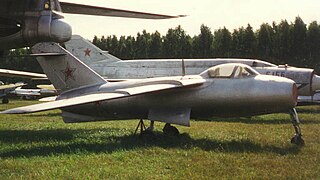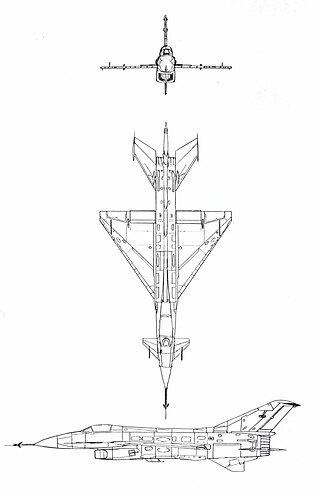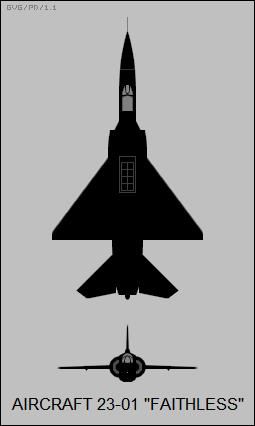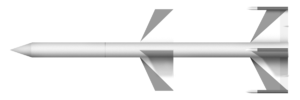"NATO reporting names" are a system of code names used by NATO to denote military aircraft and other equipment used by the post-Soviet states, former Warsaw Pact countries, China, and other countries that use such weaponry. The system assists military communications by providing short, one or two-syllable names, as alternatives to the precise proper names – which may be easily confused under operational conditions or are unknown in the western world.

The Mikoyan-Gurevich MiG-19 is a Soviet second generation, single-seat, twinjet fighter aircraft, the world's first mass-produced supersonic aircraft. It was the first Soviet production aircraft capable of supersonic speeds in level flight. A comparable U.S. "Century Series" fighter was the North American F-100 Super Sabre, although the MiG-19 primarily fought against the more modern McDonnell Douglas F-4 Phantom II and Republic F-105 Thunderchief over North Vietnam. This aircraft was originally used by the Soviet Union but it was later used by the People's Liberation Army Air Force.

Artem (Artyom) Ivanovich Mikoyan was a Soviet Armenian aircraft designer, who cofounded the Mikoyan-Gurevich design bureau along with Mikhail Gurevich.

The Mikoyan MiG-29 is a twin-engine fighter aircraft designed in the Soviet Union. Developed by the Mikoyan design bureau as an air superiority fighter during the 1970s, the MiG-29, along with the larger Sukhoi Su-27, was developed to counter new U.S. fighters such as the McDonnell Douglas F-15 Eagle and the General Dynamics F-16 Fighting Falcon. The MiG-29 entered service with the Soviet Air Forces in 1983.

The Mikoyan-Gurevich MiG-25 is a supersonic interceptor and reconnaissance aircraft that is among the fastest military aircraft to enter service. Designed by the Soviet Union's Mikoyan-Gurevich bureau, it is an aircraft built primarily using stainless steel. It was to be the last plane designed by Mikhail Gurevich, before his retirement.

The Mikoyan MiG-27 is a variable-sweep ground-attack aircraft, originally built by the Mikoyan-Gurevich design bureau in the Soviet Union and later licence-produced in India by Hindustan Aeronautics as the Bahadur ("Valiant"). It is based on the Mikoyan-Gurevich MiG-23 fighter aircraft, but optimised for air-to-ground attack. Unlike the MiG-23, the MiG-27 did not have widespread use outside Russia, as most countries opted for the Mikoyan-Gurevich MiG-23BN and Sukhoi Su-22 instead. It remains in service only with the Kazakh Air Forces in the ground attack role. All Russian, Indian, Sri Lankan and Ukrainian MiG-27s have been retired.

The Shenyang J-8 is an interceptor aircraft developed by the 601 Institute (Shenyang) in the People's Republic of China (PRC). It was conceived in the early 1960s as a low-risk program based on enlarging the Mikoyan-Gurevich MiG-21F, a version of which the PRC was producing as the Chengdu J-7. The original J-8 experienced protracted development due to disruption from the Cultural Revolution; the prototypes first flew in 1969 but the design was not finalized until 1979 with the aircraft entering service in 1980.

The Lavochkin La-15, was an early Soviet jet fighter and a contemporary of the Mikoyan-Gurevich MiG-15.

The Kaliningrad K-8 (R-8) was a medium-range air-to-air missile developed by the Soviet Union for interceptor aircraft use.
The MolniyaR-60 is a short-range lightweight infrared homing air-to-air missile designed for use by Soviet fighter aircraft. It has been widely exported, and remains in service with the CIS and many other nations.

The Yakovlev Yak-17 was an early Soviet jet fighter. It was developed from the Yak-15, the primary difference being tricycle landing gear. The trainer version, known as the Yak-17UTI, was the only Soviet jet trainer of the 1940s. Both aircraft were exported in small numbers and the Yak-17 was soon replaced by the far superior Mikoyan-Gurevich MiG-15 beginning in 1950.

Vozzhayevka (also Vozzhayevka Northeast (US)) is an air base in Amur Oblast, Russia located about 100 km southeast of Blagoveshchensk. It is a medium-sized air base located near an SS-11 missile field at Svobodnyy. During the 1980s it was one of 17 airfields hosting the Soviet Union's tactical reconnaissance aircraft regiments.

The Mikoyan-Gurevich Ye-8 was a supersonic jet fighter developed in the Soviet Union, intended to replace the MiG-21. Only two prototypes were built in 1960–61. The original MiG-21's air intakes were moved under the fuselage, freeing up the nose where a larger and more powerful radar, able to deliver longer range air-to-air missiles, could be built in. Canards were built to both sides of the nose, in front of the cockpit,.
The Mikoyan-Gurevich I-75 was the final design of a series of three experimental swept-wing interceptors developed in the Soviet Union in the mid-late 1950s by the Mikoyan-Gurevich design bureau from their Mikoyan-Gurevich I-3 airframe. All the aircraft in the I-3 program were affected by delays in the development of the Klimov VK-3 turbojet engine, its cancellation and ultimate replacement by the Lyulka AL-7F turbojet engine.

The Mikoyan-Gurevich Ye-150 family was a series of prototype interceptor aircraft designed and built by the Mikoyan-Gurevich design bureau in the Soviet Union from 1955.
The Uragan-1 was the first generation of a Soviet automatic air defense interception system, and was a component of the Soviet Air Defence Forces protivovozdushnaya oborona strany. The concept began with a Soviet Council of Ministers resolution dated February 26, 1955 and the Ministry of Aviation Industry order dated March 8, 1955. The resolutions were in response to the threat from long-range supersonic bombers such as the United States' Convair B-58 "Hustler" and the equally threatening British Vickers Valiant, among others. The current generation is the Uragan-5B.

Note: Not to be confused with the Mikoyan-Gurevich MiG-23, which was a completely different aircraft, though designed to fulfil the same specification.













